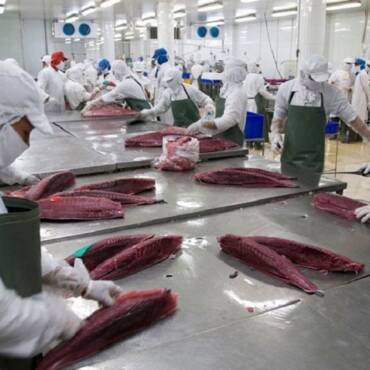Seafood exports have recovered strongly, reaching more than 8.3 billion USD after 9 months and could reach 11 billion USD this year – the highest level in the past three years.
According to the Vietnam Association of Seafood Exporters and Producers (VASEP), September export turnover reached nearly 991 million USD, up 7.5% over the same period last year. In the first 9 months, total exports reached 8.33 billion USD, up 15.5%.
In terms of product structure, shrimp continued to lead with nearly 3.4 billion USD, up 20% thanks to stable demand in the US, Japan, EU and expanded orders in Asia. Pangasius reached more than 1.6 billion USD, up nearly 10%. Marine fish, squid – octopus and shellfish all increased, while tuna decreased slightly to 705 million USD due to high competition in the ocean market.
Mr. Vu Tuan Cuong, Director of the Center for Testing, Inspection and Verification (Center 3K) under the Department of Fisheries and Fisheries Surveillance, said that the seafood industry has grown positively this year despite unfavorable weather and fluctuations in the world economy. “The target of reaching a turnover of 10.5-11 billion USD is completely feasible,” he said at the press conference to announce VietShrimp Asia 2026 and Aquaculture Vietnam 2026.
Total aquatic product output in the first nine months reached about 7.72 million tons, of which aquaculture accounted for more than 1.3 million tons and exploitation about 1.8 million tons, an average increase of 3.3%. According to Mr. Cuong, Vietnam’s advantages come not only from natural conditions but also from increasingly high processing capacity and added value. “Aquaculture is one of the important pillars of Vietnam’s agricultural economy,” he said.
However, the industry still faces major challenges from the EU’s IUU “yellow card” warning – a problem that has lasted for many years, affecting its reputation and export costs. Mr. Cuong said that this is a “test” that forces the industry to make drastic changes, similar to the period when it passed international standards such as HACCP or GlobalGAP.
In addition, from January 1, 2026, some Vietnamese fisheries may be subject to export restrictions to the US under the Marine Mammal Protection Act (MMPA) due to failure to meet conservation requirements. The list includes tuna, swordfish, squid, grouper, crab and mackerel.
To overcome this, at a recent meeting of the National Steering Committee on Combating IUU Fishing, VASEP Secretary General Nguyen Hoai Nam said the industry needs to transform towards transparency and sustainability. The focus is on digitizing the supply chain to control raw material sources, expanding the system of standard fishing ports and perfecting a unified legal framework to manage fisheries more effectively. “Import markets are increasingly strict on traceability. Digitalization will help strengthen trust with international partners,” he said.
With the same orientation of promoting transparency and integration, Mr. Cuong said that the two international exhibitions VietShrimp Asia 2026 and Aquaculture Vietnam 2026 held simultaneously in Ho Chi Minh City in March will be an opportunity for the seafood industry to affirm its position, connect with partners and expand the market.
Ms. Rose Chitanuwat, Regional Director of ASEAN at Informa Markets, said that Vietnam was chosen to host two major international industry exhibitions thanks to its large production scale and increasingly improved technological capacity. She expected that the exhibition, in addition to providing modern, environmentally friendly technology, would create a forum for businesses, managers and farmers to exchange solutions to improve quality and move towards sustainable exports.




Add Comment